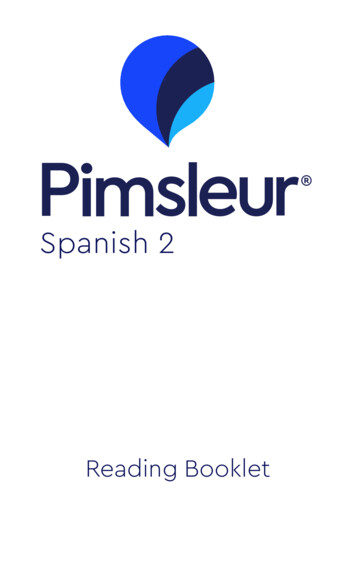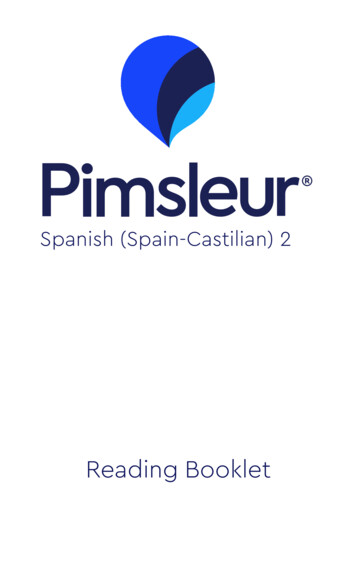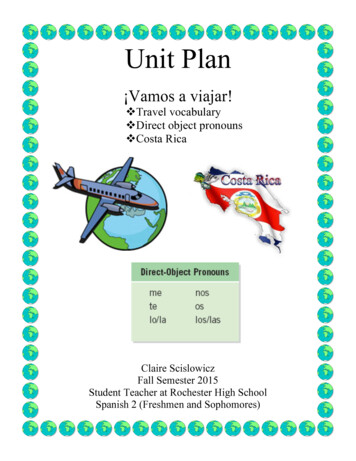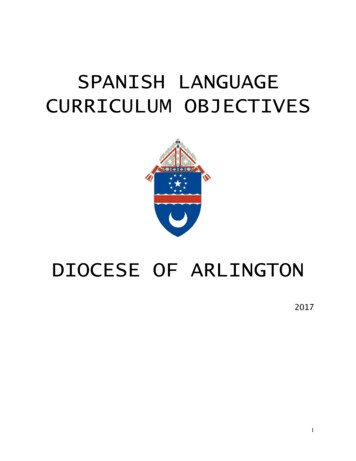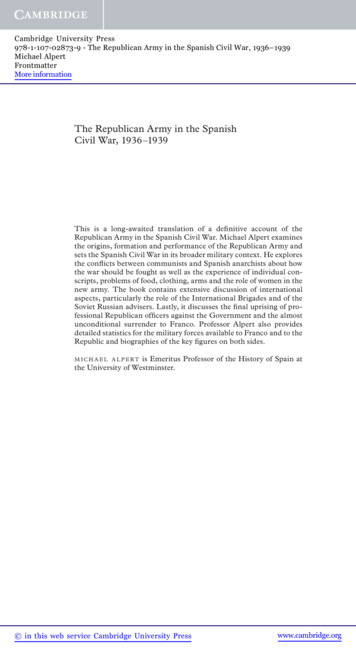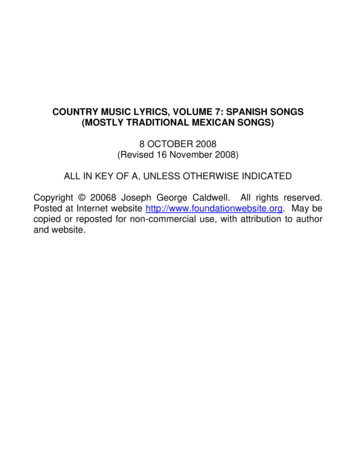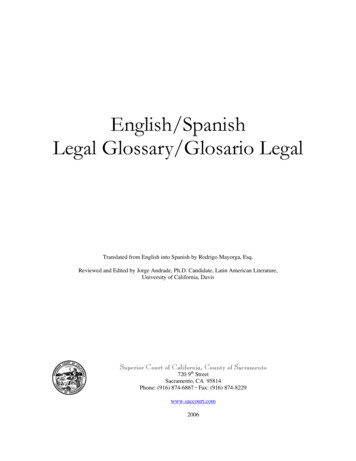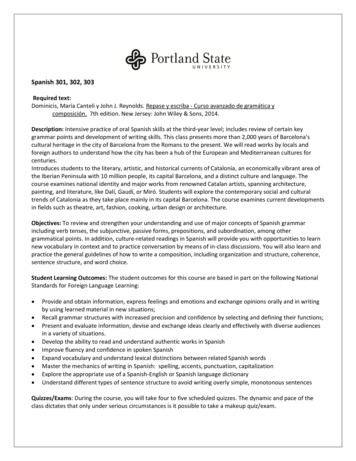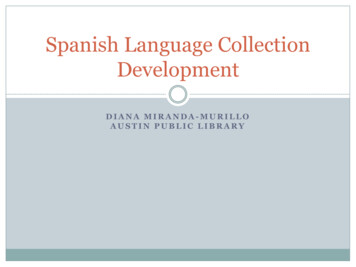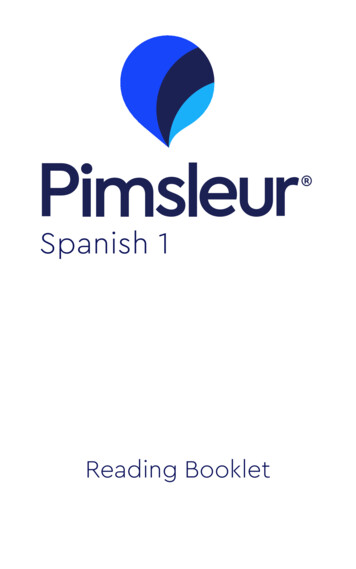
Transcription
Spanish 1Reading Booklet
Spanish 1Travelers should always check withtheir nation's State Department forcurrent advisories on local conditionsbefore traveling abroad.Booklet Design: Maia Kennedy and ‰ Recorded Program 2018 Simon & Schuster, Inc. Reading Booklet 2018 Simon & Schuster, Inc.Pimsleur is an imprint of Simon & Schuster Audio,a division of Simon & Schuster, Inc. Mfg. in USA.All rights reserved.ii
Spanish 1ACKNOWLEDGMENTSVoicesEnglish-Speaking Instructor . . . . . . . . . . . Ray BrownSpanish-Speaking Instructor . . . . . . . Christian RojasFemale Spanish Speaker . . . . . . . . Monica CanavanMale Spanish Speaker . . . . . . . . . . . . . . . . Luis CortesWritersMonica Canavan Emily TaylorEditorsPaula Billups Joan SchoellnerBeverly D. HeinleReviewerSantiago CovarrubiasProducer & DirectorSarah H. McInnisRecording EngineerPeter S. TurpinSimon & Schuster Studios, Concord, MAiii
Spanish 1Table of ContentsIntroduction . . . . . . . . . . . . . . . . . . . . . . . . . . . . . . . . . .Lesson Two . . . . . . . . . . . . . . . . . . . . . . . . . . . . . . . . . . .Lesson Three . . . . . . . . . . . . . . . . . . . . . . . . . . . . . . . . . .Lesson Four . . . . . . . . . . . . . . . . . . . . . . . . . . . . . . . . . . .Lesson Five . . . . . . . . . . . . . . . . . . . . . . . . . . . . . . . . . . .Lesson Six . . . . . . . . . . . . . . . . . . . . . . . . . . . . . . . . . . . .Lesson Seven . . . . . . . . . . . . . . . . . . . . . . . . . . . . . . . . .Lesson Eight . . . . . . . . . . . . . . . . . . . . . . . . . . . . . . . . . .Lesson Nine. . . . . . . . . . . . . . . . . . . . . . . . . . . . . . . . . . .Lesson Ten . . . . . . . . . . . . . . . . . . . . . . . . . . . . . . . . . . .Lesson Eleven . . . . . . . . . . . . . . . . . . . . . . . . . . . . . . . . .Lesson Twelve . . . . . . . . . . . . . . . . . . . . . . . . . . . . . . . .Lesson Thirteen . . . . . . . . . . . . . . . . . . . . . . . . . . . . . . .Lesson Fourteen . . . . . . . . . . . . . . . . . . . . . . . . . . . . . . .Lesson Fifteen . . . . . . . . . . . . . . . . . . . . . . . . . . . . . . . . .Lesson Sixteen . . . . . . . . . . . . . . . . . . . . . . . . . . . . . . . .Lesson Seventeen . . . . . . . . . . . . . . . . . . . . . . . . . . . . .Lesson Eighteen . . . . . . . . . . . . . . . . . . . . . . . . . . . . . . .Lesson Nineteen . . . . . . . . . . . . . . . . . . . . . . . . . . . . . . .Lesson Twenty . . . . . . . . . . . . . . . . . . . . . . . . . . . . . . . .Lesson Twenty-One . . . . . . . . . . . . . . . . . . . . . . . . . . . .Lesson Twenty-Two . . . . . . . . . . . . . . . . . . . . . . . . . . . .Lesson Twenty-Three . . . . . . . . . . . . . . . . . . . . . . . . . . .Lesson Twenty-Four . . . . . . . . . . . . . . . . . . . . . . . . . . . .Lesson Twenty-Five . . . . . . . . . . . . . . . . . . . . . . . . . . . .Lesson Twenty-Six . . . . . . . . . . . . . . . . . . . . . . . . . . . . .Lesson Twenty-Seven. . . . . . . . . . . . . . . . . . . . . . . . . . .Lesson Twenty-Eight . . . . . . . . . . . . . . . . . . . . . . . . . . .Lesson Twenty-Nine . . . . . . . . . . . . . . . . . . . . . . . . . . . .Lesson Thirty. . . . . . . . . . . . . . . . . . . . . . . . . . . . . . . . . 35557596163
Spanish 1IntroductionWelcome to the Third Edition of Pimsleur’sSpanish 1.Spanish is the most widely spoken of theRomance languages, which are a Latin branch ofthe Indo-European language group. This branchincludes French, Italian, Portuguese, and Romanian,among others. Spoken primarily in Central andSouth America and in Spain --- and by a sizeableand fast-growing population of speakers in theU.S. --- Spanish is the first language of more than350 million people, more than any other languageexcept Mandarin Chinese. It’s the official languageof twenty-one countries and is one of the six officiallanguages of the United Nations. Furthermore,Spanish is a common second language---the moststudied after English--- and the third most commonlyused on the Internet after English and Mandarin.The language can be called either “Spanish” or“Castilian.” The name “Castilian” derives from theKingdom of Castile (meaning “Land of Castles”), oneof several kingdoms that spread across the Iberianpeninsula during the Middle Ages. “Spanish” is amore recent name that first referred to Spain as acountry and was later applied to its predominantlanguage as well.
Spanish 1Modern Spanish evolved from several dialects ofLatin that were spoken in north-central Iberia duringthe 8th or 9th century. During this early period itwas influenced by local languages such as Basque.Eventually it spread into the surrounding area, particularly the south, where it was further influenced byArabic. In the 13th century, King Alfonso X (knownas “Alfonso the Wise”) was the first king to useCastilian extensively. He also began to standardizeit by assembling court scribes and supervising theirwriting --- in Castilian --- on works of history, law,astronomy, and other fields, thereby establishingCastilian as a language of higher learning.In the 15th century, Old Castilian, or Old Spanish,began to evolve into what is now Modern Spanish--- the difference being mainly one of pronunciation(the devoicing and shifting of sibilant consonants).Someone who can read Modern Spanish can learnto read Old Spanish with very little difficulty. Thedifference is much less stark than between ModernEnglish and Old English.Beginning at the end of the 15th century, theexpansion of the Spanish Empire took Spanishbeyond Spain’s borders --- to the Americas, parts ofAfrica, and several island groups in the Pacific, amongother locations. It became an important languagefor government and trade. In Africa, Spanish is nowthe official language of only Equatorial Guinea, and2
Spanish 1it is no longer spoken by many people in the Pacific.In the Americas, however, the descendants of theoriginal Spaniards continued to use Spanish; and inthe 19th century, as the colonies overthrew Spanishrule, the new leaders encouraged the populationto become fluent in Spanish in order to strengthennational unity. Today it’s the official language of mostSouth American and Central American countries.The Third EditionIf you have completed previous editions ofthis course, you will notice that a few things havechanged since the last update.Languages are constantly evolving and reflectingchanges in their societies. Spanish is no exception.Just as first names like Bernarda or Anselmo areno longer first picks for Central or South Americanbabies, the Spanish you hear spoken in Latin Americatoday is not the same Spanish you heard twenty ormore years ago, and certainly no longer the Spanishyou learned in school, even though the grammar isstill largely the same.For example, it’s no longer common to refer tothe USA as Norteamérica, but rather Estados Unidos;and instead of Perdón for Excuse me, we have introduced Disculpe, which is now used more frequently.Changes have also been made to reflect the current3
Spanish 1value of the peso, the cost of items, and the use ofthe American dollar. In general, the scenarios andconversations have been updated so that a personof any age will find them familiar and useful.Also reflected in this new edition is a generaltrend in Latin America towards casual interaction. Although speaking politely and addressingpeople correctly is always important, especiallyfor beginning language learners, it is also usefulto learn to interact more casually while traveling,working, or vacationing in Latin America. With thisrevised edition, you’ll practice asking questionsboth politely (¿Dónde quiere comer?) and casually(¿Dónde quieres comer?). You will also learn whenand where to use the casual tú form (¿Cómo estás,Sebastian?) versus the formal usted form (¿Cómoestá usted, señora?) But you will hear much less ofseñor and señora, and señorita has been phased out.With this newest edition of Spanish 1, what youare learning is neither stilted textbook Spanish,nor street Spanish, but rather everyday Spanish asspoken in Mexico and most of South and CentralAmerica. Of course there are regional accents,and expressions used in one country may not beused in another. If you travel to the seaside, thecountryside, the mountains, or small towns, youmight need to ask people to repeat themselves orspeak more slowly. This is a common occurrence in4
Spanish 1any language, and no one course can cover everypossible regional variation. However, using theSpanish taught in this course, you can expect to beunderstood throughout the Spanish-speaking world.Remember, speaking Spanish clearly andnaturally is not always easy to do at an introductorylevel, and you may want to repeat a lesson a fewtimes. The Pimsleur Method has a proven successrate and you will find that it is well worth the effort.We hope you enjoy this Third Edition.The Spanish AlphabetThe Spanish alphabet once had thirty letters.In addition to the twenty-six letters of the Englishalphabet, ch, ll, rr, and ñ were considered separateletters. However, after a revision by the SpanishRoyal Academy in the 1990s, only the ñ remains —for a total of twenty-seven letters. Some dictionariesand some Latin American countries still continue touse the old system.Unlike in English, Spanish pronunciation of theletters and letter combinations is very consistent,although again there are regional differences.For example, you may hear the ll combinationpronounced either like English “y” or like English“j.” A “y” as in the word yo may be pronounced as“y,” “j,” or occasionally “sh.” Nevertheless, once you5
Spanish 1know the basic guidelines, you will be able to readSpanish easily.Reading LessonsReading is a critical part of learning and understanding a new language, but it may be for differentreasons than you think.If you’re like most people, you learned to speakyour native language well before you learned to readit: you learned reading later—and it’s a differentskill, which uses a different part of your brain.The symbols you see on a page—the alphabet—are a sort of shorthand for the sounds they represent.Inside those sounds is where meaning actually lives.Not only is reading a piece of a language puzzle,learning to read gives you a chance to learn alanguage from a different direction than how youlearn to speak in the audio lessons. This combinationapproach will help you build a solid bridge towardfluency. You’ll be able to isolate sounds in the spokenlanguage that you couldn’t quite catch throughlistening alone, and you’ll begin to notice patternsin words that will help you create a web of understanding in your mind. This is the natural progressionDr. Pimsleur followed in all of his language courses.6
Spanish 1By the end of Lesson Two, you’ll have acquiredsome of the sounds of your new language, and theReading Lessons begin. Our approach is systematic.We’ll walk you through the sounds of the alphabet,and you’ll learn how to pronounce letters that looklike English letters but may sound very different,and, in some cases, letters that are totally new toyou. You’ll also learn the impact that a symbol oraccent has on pronunciation. You won’t find a list ofthe words or sentences taught in the audio lessons,but instead we’ll take you to the source: soundsof individual letters and letter combinations, andyou’ll learn how these sounds play out in words andsentences. Don’t be afraid to push yourself with yourpronunciation and accent. Be dramatic and havefun! The closer you can get to the native speaker’spronunciation, the more authentic your experiencewill be, and the better you’ll remember.Once you’ve mastered the sound system, you’llbe able to sound out words on sight, and soon you’llbe reading for meaning. By the end of the first thirtylessons, you will be reading at the same level as youare speaking. You’ll find a Reading Lesson at the endof each of the audio lessons in this course, startingwith Lesson Two.7
Spanish 1Lesson mana8.lleno9.moreno10.bello11.clase12.en la clase13.tenemos14.hablo15.Hablo un poco.16.hasta17.hora18.llama19.¿Cómo se llama usted?20.Me llamo Carlos.8
Spanish 1Lesson Two Translations1.little2.male friend3.road4.soon5.street6.I arrive7.week8.full9.dark-skinned / brunette10.beautiful11.class12.in the class13.we have14.I speak15.I speak a little.16.until17.hour18.you call / he, she calls19.What’s your name?20.My name is Carlos.9
Spanish 1Lesson Three1.habla2.llave3.dinero4.damas5.la dama6.delante7.por favor8.el papel9.canta10.calor11.el señor12.baño13.comer14.ella15.la niña16.comprar17.entender18.español19.Soy de Chicago.20.¿Es verdad?10
Spanish 1Lesson Three Translations1.2.you speak3.4.money5.6.the lady7.8.pleasekeyladiesin frontthe paper9.10.you sing11.12.Mr. / sir13.14.to eat15.16.the girl17.18.to understand19.I’m from Chicago.20.Is it true?heatbathroomshe / herto buySpanish11
Spanish 1Lesson Four1.Ud. (usted)2.inglés3.¿Habla inglés?4.Sí, hablo inglés.5.No hablo español.6.entiendo7.muy bien8.¿Entiende?9.¿Entiende cana14.bañar15.lloro16.¿Habla español, señorita?17.No importa.18.Estamos en Chile.19.Está bien.20.Adiós.12
Spanish 1Lesson Four Translations1.you2.English3.Do you speak English?4.Yes, I speak English.5.I don’t speak Spanish.6.I understand7.very well8.Do you understand?9.Do you understand English?10.Where?11.to know12.north13.North American woman14.to bathe15.I cry16.Do you speak Spanish, miss?17.It doesn’t matter.18.We’re in Chile.19.It’s fine.20.Good-bye.13
Spanish 1Lesson Five1.año2.las horas3.el año4.la tarde5.ellos6.bueno7.Buenas noches.8.grande9.casa10.la casa edo16.dueño17.el pollo18.dos helados19.Soy de Estados Unidos.20.Encantada.14
Spanish 1Lesson Five Translations1.year2.the hour
Pimsleur is an imprint of . except Mandarin Chinese. It’s the official language of twenty-one countries and is one of the six official languages of the United Nations. Furthermore, Spanish is a common second language---the most studied after English--- and the third most commonly used on the Internet after English and Mandarin. The language can be called either “Spanish” or .

